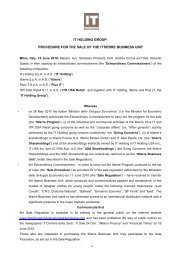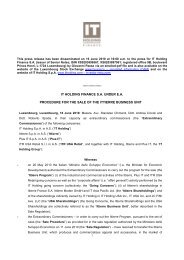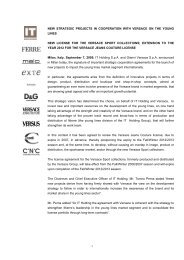Create successful ePaper yourself
Turn your PDF publications into a flip-book with our unique Google optimized e-Paper software.
Trends in the Luxury Goods Industry<br />
The luxury goods industry consists primarily of producers, manufacturers, distributors, wholesalers and retailers of<br />
apparel, perfume, cosmetics, jewelry, watches, accessories and other similar products. According to a report<br />
published in 2003 by Altagamma, a non-profit association of Italian consumer and luxury goods companies<br />
(“Altagamma”), the apparel and accessories segments of the luxury goods industry together accounted for an<br />
estimated 49% of luxury goods sold worldwide in 2003.<br />
Altagamma also estimated that the compound annual growth rate of the luxury goods market in terms of sales was<br />
9.0% for the period from 1994 to 2001. Since the events of September 11, 2001 and the general worldwide<br />
economic slowdown that ensued, luxury goods sales have remained essentially flat. Market observers, however,<br />
are forecasting that the demand for luxury goods will recover somewhat from 2005 onwards<br />
Licensed Designer Brands<br />
We produce apparel and accessories under brands, which we either own or which are licensed to us. Our portfolio<br />
of licensed brands includes D&G Dolce & Gabbana, Versus, Versace Jeans Couture, Just Cavalli and C’N’C<br />
Costume National. We intend to retain our existing licenses, as well as bid for and win new licenses that<br />
complement our existing portfolio of brands. We are exposed, however, to the risk that our existing licensors will<br />
choose not to renew these license agreements. See “Risk Factors—We are dependent on our ability to negotiate,<br />
maintain and renew license agreements with the owners of leading brands” for a discussion of our dependence on<br />
our licensed brands. Moreover, even if we are able to renew our licenses when they expire, the future profitability<br />
of our licensed brands may be impacted by the continuing efforts of licensors to assert greater control over license<br />
terms.<br />
Growth of Accessories Business<br />
During 2004, our accessories business accounted for 8.2% of our consolidated net revenues and, we believe,<br />
approximately 9.9% of our consolidated EB<strong>IT</strong>DA. We increased the net revenues of our accessories business from<br />
€24.6 million in 2002 to €58.3 million in 2004 (equivalent to a compound annual growth rate of approximately<br />
54% during that span) and believe that our portfolio of attractive brands and our unmatched production and<br />
distribution synergies leave us well-positioned to exploit projected growth trends in this market segment and to<br />
meet competition as it emerges.<br />
Exchange Rate Fluctuations<br />
We conduct, and will continue to conduct, transactions in currencies other than euro, particularly U.S. dollars,<br />
British pounds, Swiss francs, Canadian dollars and Hong Kong dollars. Consequently, our results are affected by<br />
fluctuations in the value of the euro against these and other currencies, particularly the U.S. dollar. The euro<br />
appreciated against the U.S. dollar by 22.9% during 2003 and 7.0% during 2004, based on the average U.S. dollar<br />
to euro exchange rates for 2002, 2003 and 2004. This trend has negatively affected our revenues. Although the<br />
negative impact from exchange rate fluctuations has been partially offset by gains on hedging contracts, we<br />
recorded net gain on foreign exchange of €0.9 in 2004, and net losses of €1.2 million in 2003 and €2.1 million in<br />
2002.<br />
Seasonality<br />
We experience seasonal fluctuations in the level of our revenues. These fluctuations occur because the majority of<br />
our revenues are recognized in the first quarter of each year, when we deliver most of the orders we receive for<br />
apparel and accessories from our Spring-Summer collections, and in the third quarter of each year, when we deliver<br />
most of the orders we receive for apparel and accessories from our Fall-Winter collections. In addition, revenues in<br />
the third quarter from the sale of our higher priced Fall and Winter collections are typically higher than those in the<br />
first quarter of our financial year, although margins are higher overall in the first quarter. The nature of our<br />
production cycle also means that we have greater working capital requirements in the first and third quarters of<br />
38






